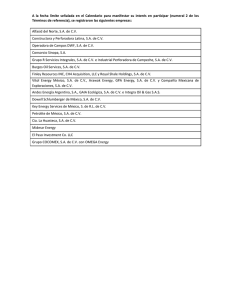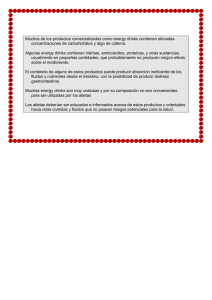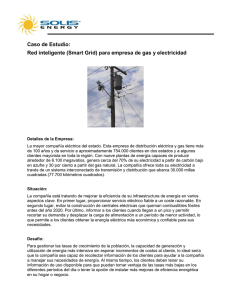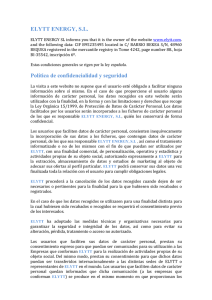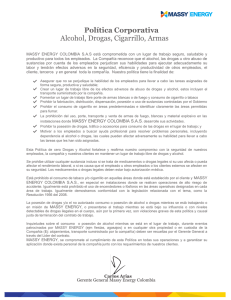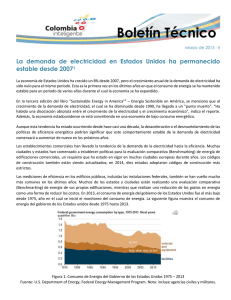Descargar
Anuncio
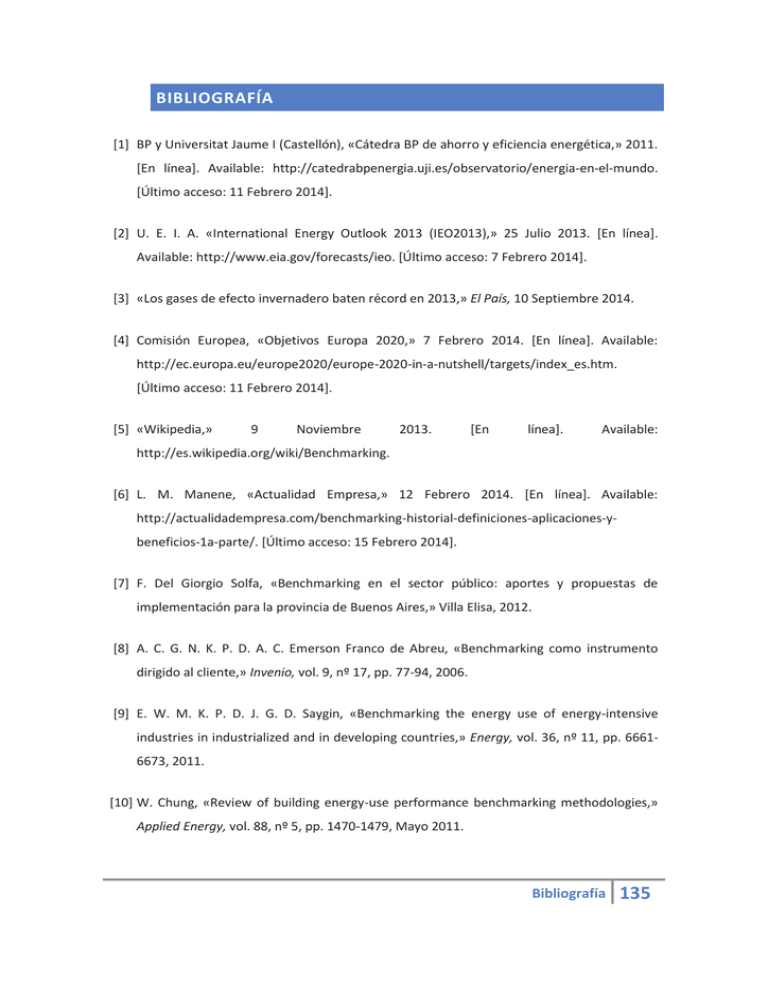
BIBLIOGRAFÍA [1] BP y Universitat Jaume I (Castellón), «Cátedra BP de ahorro y eficiencia energética,» 2011. [En línea]. Available: http://catedrabpenergia.uji.es/observatorio/energia-en-el-mundo. [Último acceso: 11 Febrero 2014]. [2] U. E. I. A. «International Energy Outlook 2013 (IEO2013),» 25 Julio 2013. [En línea]. Available: http://www.eia.gov/forecasts/ieo. [Último acceso: 7 Febrero 2014]. [3] «Los gases de efecto invernadero baten récord en 2013,» El País, 10 Septiembre 2014. [4] Comisión Europea, «Objetivos Europa 2020,» 7 Febrero 2014. [En línea]. Available: http://ec.europa.eu/europe2020/europe-2020-in-a-nutshell/targets/index_es.htm. [Último acceso: 11 Febrero 2014]. [5] «Wikipedia,» 9 Noviembre 2013. [En línea]. Available: http://es.wikipedia.org/wiki/Benchmarking. [6] L. M. Manene, «Actualidad Empresa,» 12 Febrero 2014. [En línea]. Available: http://actualidadempresa.com/benchmarking-historial-definiciones-aplicaciones-ybeneficios-1a-parte/. [Último acceso: 15 Febrero 2014]. [7] F. Del Giorgio Solfa, «Benchmarking en el sector público: aportes y propuestas de implementación para la provincia de Buenos Aires,» Villa Elisa, 2012. [8] A. C. G. N. K. P. D. A. C. Emerson Franco de Abreu, «Benchmarking como instrumento dirigido al cliente,» Invenio, vol. 9, nº 17, pp. 77-94, 2006. [9] E. W. M. K. P. D. J. G. D. Saygin, «Benchmarking the energy use of energy-intensive industries in industrialized and in developing countries,» Energy, vol. 36, nº 11, pp. 66616673, 2011. [10] W. Chung, «Review of building energy-use performance benchmarking methodologies,» Applied Energy, vol. 88, nº 5, pp. 1470-1479, Mayo 2011. Bibliografía 135 [11] Gale Boyd, Duke University Walt Tunnessen, U.S. Enviromental Protection Agency, «Promoting Energy Efficiency through Industrial Sector Benchmarking: The ENERGY STAR Approach,» 2007. [En línea]. Available: http://aceee.org/files/proceedings/2007/data/papers/68_6_098.pdf. [Último acceso: 4 Febrero 2014]. [12] N. R. Canada, «Web de Natural Resources Canada,» [En línea]. Available: http://www.nrcan.gc.ca/energy/efficiency/industry/cipec/5153?attr=24. [Último acceso: 14 Febrero 2014]. [13] M. V. P. S. M. B. F. O. E. Katharina Bunse, «Integrating energy efficiency performance in production management - gap analysis between industrial needs and scientific literature,» Journal of Cleaner Production, vol. 19, nº 6-7, pp. 667-679, 2011. [14] L. M. Manene, «Blog de Luis Miguel Manene,» 15 Abril 2011. [En línea]. Available: http://www.luismiguelmanene.com/2011/04/15/benchmarkingdefiniciones-aplicacionestipos-y-fases-del-proceso/. [Último acceso: 12 Febrero 2014]. [15] L. P. M. M. N. Z. K. N. Z. Jing Ke, «Analysis and practices of energy benchmarking for industry from the perspective of systems engineering,» Energy, vol. 54, nº 1, p. 32–44, 2014. [16] Agencia Internacional de la Energía, «Energy Efficiency Indicators: Fundamentals on Statistics,» París, 2014. [17] M. B. J.Kenneth Monts, «Assessing energy efficiency and energy conservation potential among commercial buildings: A statistical approach,» Energy, vol. 7, nº 10, pp. 861-9, 1982. [18] J. F. Lopez, S. Fernández Henao y M. M. Morales, «Aplicación de la técnica DEA ( Data Envelopment Analysis) en la determinación de eficiencia de centros de costo de producción,» Diciembre 2007. [En línea]. Available: http://www.redalyc.org/articulo.oa?id=84903768. [Último acceso: Marzo 2014]. [19] C. G. Prieto, «Análisis de la eficiencia técnica y asignativa a través de las fronteras 136 Bibliografía estocásticas de costes: una aplicación a los hospitales de INSALUD,» Valladolid, 2002. [20] A. R. Schuschny, «El método DEA y su aplicación al estudio del sector energético y las emisiones de CO2 en América Latina y el Caribe,» Santiago de Chile, 2007. [21] A. A. S. Micheo, «Naturaleza del benchmarking y su aplicación en una empresa de fabricación y distribución de calzado. Caso práctico.,» Guatemala, 1999. [22] Agencia Internacional de la Energía, «Energy Efficiency Indicators: Essentials for Policy Making,» París, 2014. [23] Agencia Internacional de la Energía, «Tracking Industrial Energy Efficiency and CO2 Emissions,» París, 2007. [24] Asociación Mundial del Acero, «Asociación Mundial del Acero,» [En línea]. Available: http://www.worldsteel.org. [Último acceso: June 2014]. [25] Confederación Europea de Industrias del Papel, [En línea]. Available: http://www.cepi.org. [Último acceso: Junio 2014]. [26] E. D. W. T. Gale Boyd, «The evolution of the ENERGY STAR energy performance indicator for benchmarking industrial plant manufacturing energy use,» Journal of Cleaner Production, vol. 16, nº 6, pp. 709-715, 2008. [27] Instituto para la diversificación y ahorro de la energía (IDAE), [En línea]. Available: http://www.idae.es. [Último acceso: Septiembre 2014]. [28] Ministerio de Industria, Energía y Turismo. Gobierno de España, «La Energía en España,» 2014. [29] L. Esteban, M. Feijoó y J.M. Hernández. Universidad de Zaragoza, «Eficiencia energética y regulación de la industria española ante el cambio climático,» Estudios de economía aplicada, vol. 21, nº 2, pp. 259-282, 2003. [30] J. A. Aranda Usón, S. Scarpellini, M. Feijoó. Universidad de Zaragoza., «Análisis de la Eficiencia Energética de la Industria Española y su Potencial de Ahorro,» Economía Bibliografía 137 Industrial, nº 352, pp. 11-24, 2003. [31] Enerdata, «Base de datos ODYSSEE,» [En línea]. Available: http://www.indicators.odysseemure.eu/energy-efficiency-database.html. [Último acceso: Junio 2014]. [32] Agencia de Protección Ambiental de los Estados Unidos, «Página web del programa ENERGY STAR,» [En línea]. Available: http://www.energystar.gov/. [Último acceso: Septiembre 2014]. [33] G.A. Boyd, Argonne National Laboratory, «Development of a Perfoarmance-Based Industrial Energy Efficiency Indicator for Cement Manufacturing Plants,» 2006. [34] Ernst Worrell y Katerina Kermeli (Universidad de Utrecht), Christina Galitsky (Lawrence Berkeley National Laboratory), «Energy efficiency improvement and cost saving opportunities for cement making,» 2013. [35] R. G. B. Harvey E. Diamond, Encyclopedia of Energy Engineering and Technology, 2008. [36] A. S. Díaz, Evaluación de la eficiencia en la educación secundaria, A Coruña: Netbiblo, S.L., 2004. [37] A. Carretero Peña y J. M. García Sánchez, Gestión de la eficiencia energética: cálculo del consumo, indicadores y mejora, Madrid: Aenor, 2012. [38] B. E. B.-U. Ernesto D. Shilder, «Análisis de la eficiencia técnica mediante funciones estocásticas de frontera: el caso de la cuenca lechera central argentina,» de Reunión anual de la asociación argentina de economía agraria en huerta grande, Córdoba (Argentina), 1993. [39] Grupo de Estudios en Microeconomía Aplicada. Universidad EAFIT, «Análisis de eficiencia. Técnica de fronteras estocásticas,» Medellín (Colombia). [40] K. E. W. J. d. B. Dian Phylipsen, «Benchmarking the energy efficiency of Dutch industry: an assessment of the expected effect on energy consumption and CO2 emissions,» Energy Policy, vol. 30, nº 8, pp. 663-679, 2002. 138 Bibliografía [41] E. W. M. P. D. G. D. Saygina, «Benchmarking the energy use of energy-intensive industries in industrialized and in developing countries,» Energy, vol. 36, nº 11, pp. 6661-6673, 2011. [42] C.-F. H. W.-C. L. G.-B. H. David Yih-Liang Chan, «Energy efficiency benchmarking of energyintensive industries in Taiwan,» Energy Conversion and Management, vol. 77, pp. 216220, 2014. Bibliografía 139
